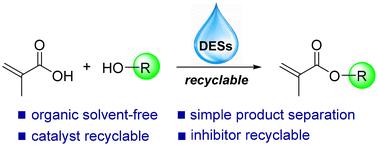Ternary deep eutectic solvents for esterification of 2-methylpropenoic acid with alcohols†
IF 4.6
Q2 MATERIALS SCIENCE, BIOMATERIALS
引用次数: 0
Abstract
In this paper, a set of novel ternary deep eutectic solvents (T-DESs) is synthesized and applied in the esterification of 2-methylpropenoic acid with alcohols. T-DESs have multiple functions, serving as a catalyst, polymerization inhibitor, and solvent, and demonstrate excellent catalytic esterification reaction activity (up to 96% yield). The optimal T-DESs 1 can be recycled 14 times without any decrease in its catalytic activity, thus solving the problems of methacrylate product separation with a polymerization inhibitor, catalyst recovery, and organic solvent pollution.


用于 2-甲基丙烯酸与醇酯化的三元深共晶溶剂
本文合成了一组新型三元深共晶溶剂(T-DES),并将其应用于 2-甲基丙烯酸与醇类的酯化反应。T-DES 具有多种功能,可用作催化剂、聚合抑制剂和溶剂,并表现出优异的催化酯化反应活性(产率高达 96%)。最佳的 T-DES 1 可循环使用 14 次,其催化活性不会降低,从而解决了甲基丙烯酸酯产品与聚合抑制剂分离、催化剂回收和有机溶剂污染等问题。
本文章由计算机程序翻译,如有差异,请以英文原文为准。
求助全文
约1分钟内获得全文
求助全文

 求助内容:
求助内容: 应助结果提醒方式:
应助结果提醒方式:


